More people than ever at this year’s AGM
The PFLA AGM is never boring – in fact, the formal part of the procedure is done and dusted in 15 minutes, leaving the rest of the time to hear about the significant and exciting progress made over the past year.
This year’s keynote speaker was Daniel Nowland, head of technical for the Jamie Oliver Group – reflecting on visits he has made to Pasture for Life farms and offering a consumers-eye view of future meat consumption.
First visit
On the afternoon before the AGM, 30 or so delegates met at the top of Birdlip Hill, at the National Trust’s Crickley Hill. While a bit wet and miserable, the views across Gloucester and beyond to the Welsh mountains were outstanding.
Area ranger Matt Stanway told how he manages the herd of Pasture for Life pedigree belted Galloway suckler cows and calves on a host of sites, many of which are popular recreational spaces with the public and their dogs.
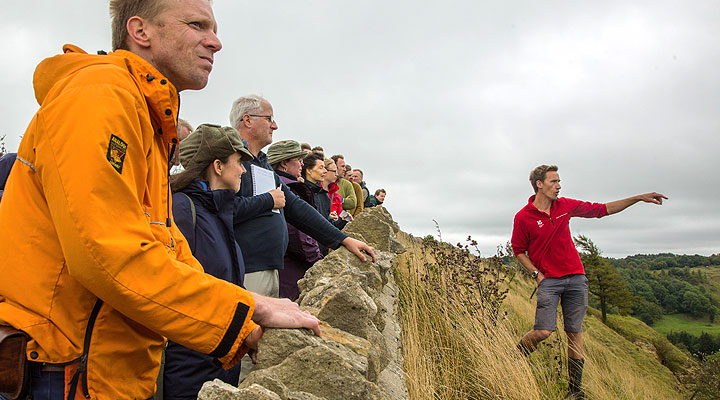
Nature conservation is the key objective, and the animals are extensively grazed throughout the year, with the numbers of grasses, herbs and wildflowers increasing every year, and insect and bird numbers on the rise too. The land manager is delighted with the progress that has been made.
The cows calve when they are three years old in the spring and enjoy a good life until retirement at ten years of age. Twelve animals are slaughtered every autumn and sold through the Ebworth Beef fresh meat box scheme.
“While the cattle are doing a fantastic job encouraging wildflowers and herbs for very little input, our staffing costs for checking all the groups across the sites is very high,” explained Matt during the visit.
“So without any grants or subsidies, the cattle make a loss of £15,000/year. But adding in the financial returns from Single Farm Payment, Higher Level and Countryside Stewardship schemes, the cattle make a £25,000 profit, with all staff costs covered.
“We should probably now start thinking about how we market our Pasture for Life meat better and look to maximise our revenues from each animal, including selling their distinctive hides and developing merchandise to sell to the public who come here to walk and picnic.
“A new shop and café has just opened at Crickley Hill and we could definitely do more to promote our meat from here.”
Converting consumers to Pasture for Life meat
Certified Pasture for Life beef and lamb is at the ‘top of the tree’, as it is delicious, ethical and guilt-free, according to Daniel Nowland, head of technical for the Jamie Oliver Group.
Speaking at the Pasture-Fed Livestock Association’s AGM at the Royal Agricultural University, Daniel described to the 100 or so delegates, his thoughts on meat, livestock and the modern consumer.
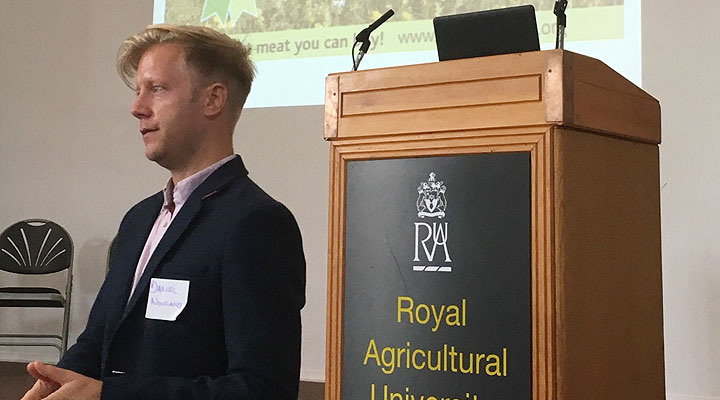
He said that some types of meat have been getting a very bad press lately, but not all meat should not be tarred with the same brush.
Looking way back in history, to gain calories everyone had to hunt and chase prey. This was sustainable, there was no waste and food had a real value, as without it people would die.
In the early cities, 80% of the people grew food close to the city and fed the lucky 20%. But they still had a connection with where the food had come from.
In the modern day, less than 1% of the population is growing or providing the food and the connection between the public and farming has disappeared, with dangerous consequences. Unfortunately, people now have very big appetites for very cheap food.
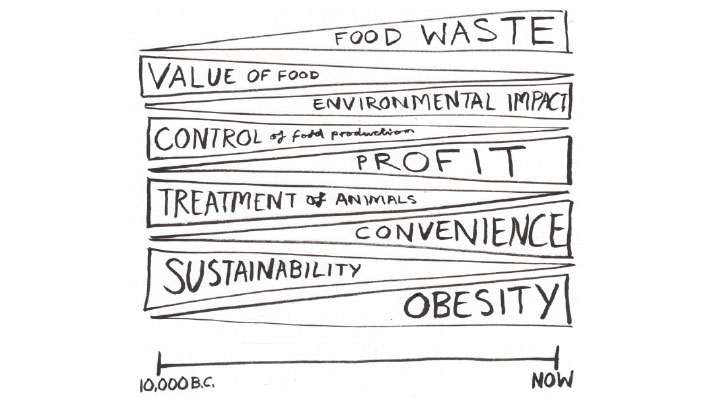
Differing concerns
Buying decisions alter radically depending on social background. People living in inner city high-rise flats want to know:
- How much is it?
- Will it feed my family?
- Is it on offer?
- How do I cook it?
While the lucky middle-classes want to know:
- Where did it come from?
- Is it good for me?
- Was it treated nicely?
- Will it be delicious?
- Do we have enough Malbec?
When people buy meat there are several distractions to buying – the ‘guilt’ or ‘pride’ factors.
Guilt factors include:
- It’s probably not great quality but it was on offer
- I normally buy organic, but I was in a hurry today
- I’ve seen the poor farmers on the news – I must go to the butcher one day
Pride factors include:
- It was expensive but it was organic
- I know the animal had a good life, as I have seen them on the farm
- It’s from a local farmer who really cares for his animals
So what does the responsible meat eater of the future look like?
- They like meat – but are happy to eat vegetarian for a few meals in the week – flexitarian?
- Meat is regarded as a treat – not a commodity
- They care about animal welfare and environmental sustainability
- They prefer quality over quantity
- They are sceptical about the ethics of supermarket meat
Genuine food
Daniel described Pasture for Life meat as genuine food that is guaranteed to be ethical and sustainable – through its insistence of being 100% grass-fed, with no grain.
He feels that the Pasture for Life farmers need to move the unconscious consumer towards becoming a conscious consumer – someone who recognises that not all meat is the same, and actually stops to think about where their food comes from.
“There are no flaws in the Pasture for Life system; welfare is good, the animals are helping protect the environment and the meat is healthy to eat.
“I have met a few of the certified PFLA members and have huge respect for what they are achieving. I believe there is massive opportunity for 100% grass-fed meat to grow from where it is today.”
Beef tasting
There was a tasty treat for lunch – four pieces of certified 100% grass-fed beef from four local farmers. These were all roasted the same way in the same kitchen and served at the same time.
The meat was:
- A Hereford from Ian and Cathy Boyd, Whittington Lodge Farm, Whittington
- A 25 month old traditional Hereford steer from Jonathan and Mel Brunyee, Conygree Farm, Cheltenham
- A three and a half-year-old Red Poll cow from Rebecca Charley and Richard Spyvee, Ruscombe Farm, Stroud
- A pedigree Belted Galloway, Matt Stanway of the Ebworth Estate, Painswick
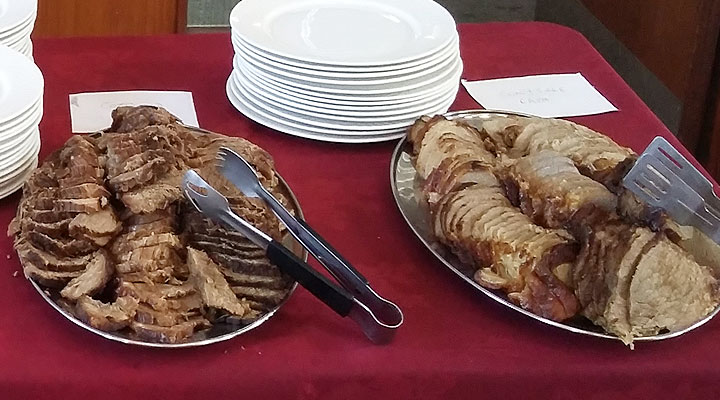
As in all the tastings the PFLA has carried out, they all tasted delicious and they all tasted deliciously different to each other. This reflects the differing types of grazed feed the animals had eaten during their lives.
The textures of the meat ranged from smooth to open to juicy, while some of the words used to describe them included herbal, minerally, fulsome and rich.
Final visit
The final visit was to Duchy Home Farm at Tetbury to hear from farm manager David Wilson about the organic mixed farming system there. The farm has recently become certified Pasture for Life, as no grains are fed to the beef cattle or sheep.
Prince Charles made his pioneering decision to convert this farm to organic in 1986. There are now 180 Ayrshire dairy and 150 suckler cows and their calves and 150 breeding Lleyn ewes mated to a Hampshire Down sire.
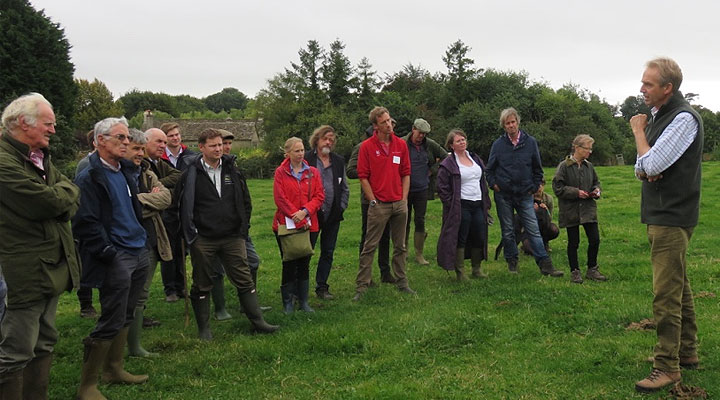
The soils, which vary widely from limestone brash to heavy clay and acid Tetbury sand, are planted with a seven year rotation, with three years of clover and grass, followed by winter wheat, potatoes, winter oats, spring beans or rye.
In an effort to build fertility, mustard and rape are drilled as cover crops to make sure the ground is covered for most of the time.
“If you are not putting enough restorative crops back into the ground, the arable crops will soon tell you,” remarked David.
David referred to the American novelist and environmentalist Wendell Berry, who commented that ‘eating is an agricultural act’. Everything David does on the farm is done to promote the well being of the soil, the animals and the animals’ gut health, running a truly sustainable, rather than an exploitative system.
“Grass-fed meat is where my heart lies,” he said. “Grazing animals on grass gets a very big tick in my book.”
The dairy herd yields 6,000 litres of milk a year off one tonne of organic oats, concentrate and beans. Autumn calving, the cows are fed a grass silage total mixed ration and the cows perform for six or seven lactations – many more than the UK average of 2.7.
The Aberdeen Angus suckler herd and the flock of sheep graze permanent pastures, which are floristically diverse. Hay from the Highgrove meadows are brought over to the fields to spread its seeds.
“There is a lot of evidence that what we are doing is right, in terms of the nutritional quality of our meat,” said David.
“I am worried that we are always trying to get more and more out of our animals – we want faster growth rates but what does this do to the traits conferring nutritional composition? We might be losing important elements like these in our quest to produce bigger and faster growing animals.”



